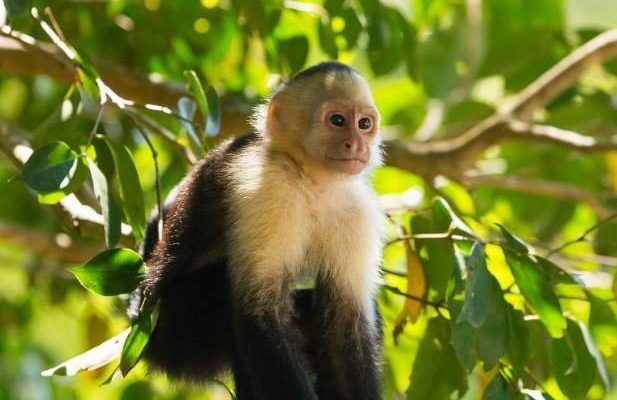![Comparing The Capuchin Monkey Vs. [Similar Species]](https://gudri.com/wp-content/uploads/2025/06/Comparing_The_Capuchin_Monkey_Vs___Similar_Species__image_0.jpg)
You might be wondering: how do these two compare when it comes to their behavior, habitat, and lifestyle? Well, it’s like comparing apples to oranges, but both fruits are equally delicious in their own ways. Let’s dive into the differences and similarities between capuchin monkeys and squirrel monkeys, peeling back the layers of each for a clearer picture.
Physical Characteristics of Capuchin Monkeys
Capuchin monkeys are small to medium-sized primates, usually weighing between 3 to 9 pounds. These guys are often recognized by their striking coloration. They have a creamy or yellowish fur on the belly and a darker brown or black fur on their back and head. Their expressive faces, complete with large, dark eyes, give them a curious and mischievous look.
What’s really interesting is their prehensile tail, which is like a fifth limb! This tail helps them balance while navigating the treetops. Imagine you’re walking a tightrope—having that extra support makes a big difference. Their limbs are also quite strong, aiding them in climbing and leaping from branch to branch, which they do with remarkable grace.
Physical Characteristics of Squirrel Monkeys
On the flip side, squirrel monkeys are even smaller than capuchins, typically weighing about 1.5 to 2.5 pounds. These little guys have a distinctive look, too, with a more vibrant coloration. Their fur is mostly a mix of yellow and olive green, and they have striking black and white markings on their faces.
Squirrel monkeys also possess a long, non-prehensile tail that they use primarily for balance. It’s interesting to note that, unlike capuchins, they rely more on their limbs for climbing rather than using their tails for support. Picture a tiny, energetic gymnast—squirrel monkeys zip around in the trees, showcasing incredible agility and speed.
Habitat and Distribution
Capuchin monkeys are mostly found in Central and South America. They thrive in various tropical forests, including rainforests, dry forests, and even mangroves. They prefer areas with plenty of trees since they spend much of their time up high, searching for fruits, nuts, and insects.
In contrast, squirrel monkeys primarily inhabit the tropical forests of South America, particularly in the Amazon Basin. While they also enjoy the trees, you might find them in slightly more varied environments, such as savannas and floodplain forests. Their adaptability allows them to make the most of different habitats, which is an impressive survival trait.
Social Structure and Behavior
When it comes to social life, capuchin monkeys have a complex hierarchy. They live in groups called troops, which can range from 10 to 50 individuals. These troops often consist of multiple adult females and their offspring, with a few dominant males. Their social structure is fascinating—like a soap opera, but in the jungle! They communicate through various vocalizations, facial expressions, and even grooming behaviors, promoting social bonds among members.
Squirrel monkeys also live in groups, often larger than capuchins, sometimes exceeding 100 individuals! They have a more egalitarian social structure, where every member has a role. They are social butterflies, spending a lot of time grooming each other and playing, which helps to strengthen their community ties. Their vocal communication can be quite loud, often resembling a series of high-pitched squeaks.
Diet and Feeding Habits
Capuchin monkeys are known for their diverse diet, which includes fruits, seeds, nuts, insects, and even small vertebrates. Their intelligence plays a big role in their foraging techniques. They’re not just eating what they find; they can also use tools! For example, they have been observed using sticks to extract insects from tree bark. This crafty behavior showcases their adaptability and problem-solving skills.
Squirrel monkeys, on the other hand, primarily focus on fruit and insects, but they also enjoy other plant materials. They have sharp teeth designed for munching on tough fruits, making it easier for them to consume their favorite snacks. While they may not use tools like capuchins, their agility allows them to quickly leap from branch to branch in search of food.
Conservation Status and Threats
Both capuchin and squirrel monkeys face significant threats due to habitat loss caused by deforestation and human encroachment. Capuchins are classified as “vulnerable,” meaning they are at risk of extinction if conservation efforts aren’t strengthened. Squirrel monkeys, while currently more stable, are still under pressure from habitat destruction and illegal capture for the pet trade.
Protecting their natural habitats is crucial, not just for these monkeys but for the entire ecosystem. Organizations are working tirelessly to conserve the areas these monkeys call home, ensuring that future generations can enjoy watching them swing through the trees.
Captive Care and Interaction with Humans
Capuchin monkeys are often seen in movies and television shows, showcasing their charming personalities. This popularity has led to them being kept as pets, but here’s the thing: they require a lot of attention, space, and stimulation. If you’re considering one as a pet, be prepared for a lifelong commitment—they can live up to 25 years in captivity!
Squirrel monkeys are also kept in captivity, but they’re less common as pets. They thrive in social settings, so if you ever visit a zoo, you’ll likely see them in groups. They’re playful and curious, making them crowd favorites during interactive exhibits. Just like with capuchins, potential owners should consider adoption from a rescue or sanctuary rather than purchasing from breeders.
To wrap it up, both capuchin monkeys and squirrel monkeys are extraordinary creatures that share a close bond while exhibiting unique traits and behaviors. Whether you’re drawn to the crafty capuchin or the energetic squirrel monkey, understanding these similarities and differences helps us appreciate their importance in the wild. So next time you come across a cute monkey video, you’ll know a bit more about these fascinating primates!

